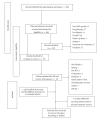Systematic review of the effect of diet and exercise lifestyle interventions in the secondary prevention of coronary heart disease
- PMID: 21197445
- PMCID: PMC3010651
- DOI: 10.4061/2011/232351
Systematic review of the effect of diet and exercise lifestyle interventions in the secondary prevention of coronary heart disease
Abstract
The effectiveness of lifestyle interventions within secondary prevention of coronary heart disease (CHD) remains unclear. This systematic review aimed to determine their effectiveness and included randomized controlled trials of lifestyle interventions, in primary care or community settings, with a minimum follow-up of three months, published since 1990. 21 trials with 10,799 patients were included; the interventions were multifactorial (10), educational (4), psychological (3), dietary (1), organisational (2), and exercise (1). The overall results for modifiable risk factors suggested improvements in dietary and exercise outcomes but no overall effect on smoking outcomes. In trials that examined mortality and morbidity, significant benefits were reported for total mortality (in 4 of 6 trials; overall risk ratio (RR) 0.75 (95% confidence intervals (CI) 0.65, 0.87)), cardiovascular mortality (3 of 8 trials; overall RR 0.63 (95% CI 0.47, 0.84)), and nonfatal cardiac events (5 of 9 trials; overall RR 0.68 (95% CI 0.55, 0.84)). The heterogeneity between trials and generally poor quality of trials make any concrete conclusions difficult. However, the beneficial effects observed in this review are encouraging and should stimulate further research.
Figures




References
-
- Mackay J, Mensah G. The Atlas of Heart Disease and Stroke. Part three: the burden. Deaths from Coronary Heart Disease. World Health Organisation, 2004, http://www.who.int/cardiovascular_diseases/resources/atlas/en/
-
- British Heart Foundation. Mortality. August 2010, http://www.heartstats.org/topic.asp?id=17.
-
- Pashkow FJ. Issues in contemporary cardiac rehabilitation: a historical perspective. Journal of the American College of Cardiology. 1993;21(3):822–834. - PubMed
-
- Leon AS, Franklin BA, Costa F, et al. Cardiac rehabilitation and secondary prevention of coronary heart disease: an American Heart Association scientific statement from the Council on Clinical Cardiology (subcommittee on exercise, cardiac rehabilitation, and prevention) and the Council on Nutrition, Physical Activity, and Metabolism (subcommittee on physical activity), in collaboration with the American Association of Cardiovascular and Pulmonary Rehabilitation. Circulation. 2005;111(3):369–376. - PubMed
-
- Oldridge NB, Guyatt GH, Fischer ME, Rimm AA. Cardiac rehabilitation after myocardial infarction. Combined experience of randomized clinical trials. Journal of the American Medical Association. 1988;260(7):945–950. - PubMed
Grants and funding
LinkOut - more resources
Full Text Sources
